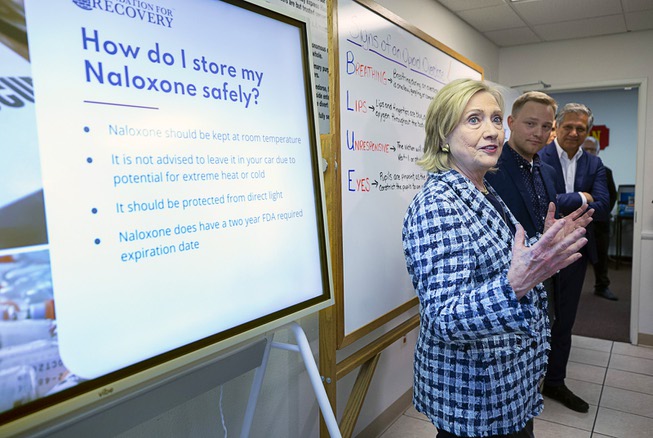
Former Secretary of State and former first lady Hillary Clinton tours the Foundation for Recovery in Las Vegas Wednesday, May 24, 2023. A tour and news conference by Clinton at the Foundation for Recovery office were part of the efforts by the Clinton Global Initiative to prevent overdose deaths.
Thursday, May 25, 2023 | 2 a.m.
Rob Banghart estimates overdosing on heroin or opioids more than a dozen times while living on the streets of Las Vegas. He bluntly says he shouldn’t be alive.
“I’d be lying if I gave an exact number (of overdoses),” Banghart told the crowd Wednesday at the Foundation for Recovery in the central valley, before continuing into a story of how he was revived by another homeless person who was carrying the overdose-reversing drug naloxone one night.
Banghart, who says he is sober and now serves as the outreach director Foundation for Recovery, was one of two individuals who shared his fight with addiction with former Secretary of State Hillary Clinton, who was at the Foundation for Recovery to meet with 30 volunteers assembling overdose distribution kits.
The group is a community nonprofit led by volunteers and staff in recovery from mental health and substance abuse disorders.
Each kit comes with three vials of naloxone, also known by the brand name Narcan, as well as individually-packaged syringes, alcohol wipes and latex gloves. Since 2019, the Clinton Foundation has supplied more than 20,000 doses of naloxone to the Foundation for Recovery and more than 720,000 doses to additional community organizations across 21 states.
Clinton, the 2016 Democratic presidential nominee, told the Sun after the event that the Clinton Foundation had worked closely with the Foundation for Recovery since launching an overdose awareness campaign in 2011. She said the Foundation for Recovery had become a model for other states because it offered services like one-on-one counseling and job training under a single statewide initiative.
“They’re a great example of a statewide effort and was one of the first brick-and-mortar support centers,” Clinton said. “To tackle this crisis, I think we’re going to need the public and private sectors to come together. I really do.”
The Clintons also have been affected by the nation’s opioid epidemic, she said.
Clinton has known personally of five young people who have died in recent years, ranging from a former State Department staffer, to a neighbor across the street from their New York home, or the daughter of a “dear friend,” she said.
Estimates released last week by the Centers for Disease Control and Prevention suggest approximately 109,680 people in the U.S. died from drug overdose in 2022, with the majority of those stemming from opioid or fentanyl use. That number has risen every year since 2018, when under 70,000 overdose deaths were recorded.
In Nevada, 949 people died of drug overdoses in 2021, according to the CDC.
For those like Banghart, or Donica Martinez, who also met with Clinton to share her experience of being revived with naloxone, having access to such an antidote can not only be the difference between life and death but can also serve as a vital wakeup call to finally seek help.
Martinez had been homeless for about seven years, and was with friends when she began overdosing. Fortunately for her, those she was with already had Narcan on them.
“This Narcan was there because of the fact we have organizations like this, street outreach organizations, that pass these out to us,” said Martinez, who has been sober for more than a year. “If it was not given that day, then I would not be here today.”
Sean O’Donnell, executive director of the Foundation for Recovery, presented a plaque to Clinton on behalf of the Las Vegas mayor’s office and city council proclaiming May 24, 2023, “Secretary Clinton and the Clinton Foundation Day” throughout the city. Councilwoman Victoria Seaman, a Republican running for mayor, was also in attendance.
Whether it’s partnering with state or local officials, nonprofit organizations, faith leaders or a combination of those, Clinton says she believes it will take the totality of a community to put judgment aside and help those who are in clear need of it.
“They can’t recover if we ignore them, dismiss them, marginalize them, mistreat them or deny resources for them and think prison is the next answer instead,” Clinton said. “It is all about separating us from the differences that divide us and finding common ground because when we work together, guess what, we get really great things done.”
New technologies
Clinton was joined in her tour by Joe Kiani, founder and CEO of Masimo, a medical technology company that specializes in wearable health devices. Company representatives were there to showcase two devices that have the potential to provide life-saving intervention during a potential overdose.
The so-called Opioid Halo contains a pulse oximeter sensor attached to the user’s fingertip while connected to a wristband that is also worn by the user, each of which are connected to the user’s smartphone via Bluetooth connection. The device provides real-time monitoring to watch for slowed breathing and will send audible alerts to the wearer and designated safety contacts.
The Halo also has a setting that will dispatch a wellness call that could lead to an EMS dispatch, Kiani said. “We can hopefully save tens of thousands of lives a year,” Kiani said, adding that it gained approval from the Food and Drug Administration just last month. “This is basically taking what we have in hospitals, and shortening it down to a wearable sensor that can last for about a week, if you wanted to wear it all day and all night.”
Kiani also demonstrated a device called the Bridge, a small electrical nerve stimulation device worn behind the ear that he says helps “significantly” reduce opioid withdrawal symptoms, and is designed for use in medication-assisted therapy with substances like naltrexone to wean patients from opioid dependency.
A prescription is required to obtain the Bridge, but studies show opioid withdrawal symptoms decreased by as much as 85% within one hour of use, according to Masimo’s website.
“I’ve heard people tell me this: They’re addicts and they first take opioids to get high, but then they take opioids because they can’t deal with the withdrawal,” Kiani said. “The withdrawals are so painful that it makes them vomit, it’s painful, (and) it’s really unfortunate.”
Clinton said Kiani had been “the most extraordinary partner” when it comes to outside-the-box solutions to the ongoing crisis.
“(Kiani) is someone who is truly on the frontlines trying to find ways to help people not just overdose, but prevent overdoses and then assist with recovery,” Clinton said.
What to do in an overdose situation
Those interested in learning more about the overdose readiness kit, which are available to companies, EMTs, police and members of the public at no cost, can visit forrecovery.org.
Naloxone typically comes in a vial or nasal spray form. Nasal spray applicators work by simply putting the nozzle up a nostril and spraying it, while it is encouraged to administer a syringe of naloxone to any general area of large muscle, like the thigh, upper arm or buttocks.
Visible indicators like blue lips or fingertips may indicate the body isn’t receiving much new oxygen, especially if the person suspected of overdosing is lethargic or unresponsive, said Chris Marx, a training specialist at the foundation.
Most often, their breathing will be short and shallow, and their pupils will appear extremely small. “Almost like the tip of a pen,” Marx said.
Marx said that naloxone had no negative side effects for someone who hasn’t ingested an opioid. But when intervening in a potential overdose, every second matters, meaning it’s better to administer naloxone than nothing at all.
Once an initial dose of naloxone has been administered, call 911 and begin doing CPR, if possible, Marx said. If the person is still unresponsive after two or three minutes, administer another dose before attempting additional CPR.
When speaking to 911 dispatchers, Marx said, it’s important to relay to them if a person is not breathing or unresponsive, and that may increase response time from first responders. Nevada law also allows for people to call police to report an overdose without fear of facing legal action if acting in good faith.
When it comes to storing naloxone, the drug has a two-year shelf life, according to the FDA. Naloxone should not be stored in areas exposed to direct sunlight or extreme heat, Marx said.

